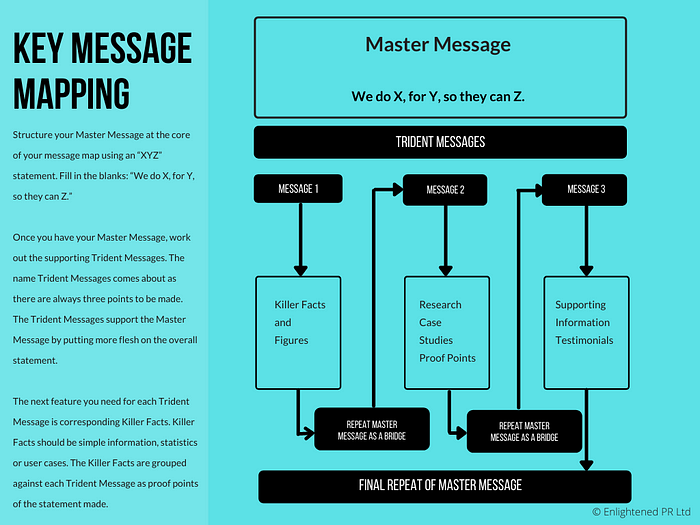Key Message Mapping — The Magic of 3
When introducing a new company or concept, it is important to be clear of the Key Messages to be conveyed throughout any communications with the media, stakeholders and influencers. Well trained company spokes people will always be equipped with a crib-sheet they prepare in advance of any given campaign.

The best practice for modern Key Messages involves the development of a Master Message; 3 supporting Key Messages; and the proof points (Killer Facts) that offer backup and/or more detail.
The process of formulating your Key Messages is as follows:
Formulate 3 bullet points to summarise the overview of what you want to say. This information needs to be developed into memorable sound bytes by producing Key Messages.
The first stage is to think about and hone your script. Firstly, what are Key Messages? A great deal is talked about this — the need to stay “on message” is a regular feature of business and political life. This phrase is often interpreted in an unfortunate, constrictive way, implying the need to tow the line and only say what is bland and acceptable.
Key Message development is the art of taking the complex and boiling it down to easily understandable points that everyone can remember and instantly understand. Messaging is about working out the headlines that will make people remember your story.
There is a process we developed and used over the years to help clients work out their key messages, which we call Message Mapping. Message Mapping is where we use the magic of the number three to deliver your point.
Finding your “Master Message”
First of all you need to be clear about your Master Message. This is the “one big thing” you want to get across to your audience. You should also be able to express it in a single sentence and ideally without any commas or phrases in parenthesis. Master Messages, need to be simple and straight forward and should avoid conditional clauses of “grey words” — words which reflect vague position, thoughts and feelings.
The Master Message ideally is no more than 27 words in length. It takes nine seconds to say 27 words out loud. Reporters and editors love nine-second sound bytes. A Master Message works because when the language is simple, it appeals to the person receiving the message, rather than simply telling them about how good you are. Instead the message communicates a benefit. The sentence is direct and like all good messages it wets the appetite. How can I be better off? What is so special about your business? It must be a message that intrigues and leads us on to ask more questions.
One way to structure your Master Message at the core of your message map is to use an “XYZ” statement. Fill in the blanks: “We do X, for Y, so they can Z.”
The beauty of three — Trident Messages to make your point
Once you have your Master Message, we need to work out what we call the supporting Trident Messages. The name Trident Messages comes about as there are always three points to be made — like the three points on a trident spear. The Trident Messages support the Master Message by putting more flesh on the overall statement. The Trident messages are:
- Xxx takes action for ….
- Xxx is trustworthy and can help
- Xxx will ensure…
Killer Facts
The next feature we need for each Trident Message are some Killer Facts. Killer Facts are the nuggets of information or data that prove the points of your Trident Messages. Ideally, Killer Facts should be simple information, statistics or user cases.
The Killer Facts are grouped against each Trident Message. The purpose is to build a composite case so that when you are delivering your message, each layer builds upon the previous point to create a compelling argument.
One way of doing this is the use of the Master Message as a bridge between Trident Messages. Once the final Trident Message and supporting Killer Facts are stated, then the whole speech should be finally rounded off with a repeat of the Master Message for good measure.
So the flow might be like this:
Master Message: -
Users will be better off with Xxx Company…
Trident Messages coupled with Killer Facts: -
There are three main reasons why businesses will be better off with Xxx Company…
1. Firstly Xxx makes you more profitable …. — support with Killer Facts
2. Xxx is trustworthy and can help… — support with Killer Facts
3. Xxx will ensure… — support with Killer Facts
These are the main reasons why businesses will be better off with Xxx Company (end by repeating Master Message)

Message mapping is a key strategy in effective risk and crisis communication. It helps organize thoughts and key points. In a high-concern, low- trust setting, the public’s ability to process information is altered. The proper use of message mapping can help crisis managers overcome this obstacle and connect with the public. They can then inform and reduce misinformation.
If an organisation exists — it communicates. Every company uses messaging and positioning. Whether or not it’s effective is another question. Key Message Mapping is the foundation to your communications strategy.
Here are 7 key take-aways to help you:
1. Limit the number of key messages to three, using as few words as possible, ideally no more than 9 seconds for broadcast and 27 words for print.
2. Construct messages that can be easily understood. This can be tested using the “readability” utility in word-processing programmes
3. The most important messages should occupy the first and last position in a list.
4. Cite third parties or sources that are perceived as credible by the receiving audience.
5. Develop graphics, visual aids, analogies and narratives (such as case studies) to communicate supporting Killer Facts.
6. Present the full message map using the repetitive structure found in the “Tell me, Tell me more, Tell me again model: tell people the information in summary form (i.e., the three Key Messages; tell people more (i.e., the supporting information); and tell people again what was told in summary form (i.e., repeat the three key messages).
7. Ideally, each message should be able to stand alone as a quote without reference to other messages in the map.
